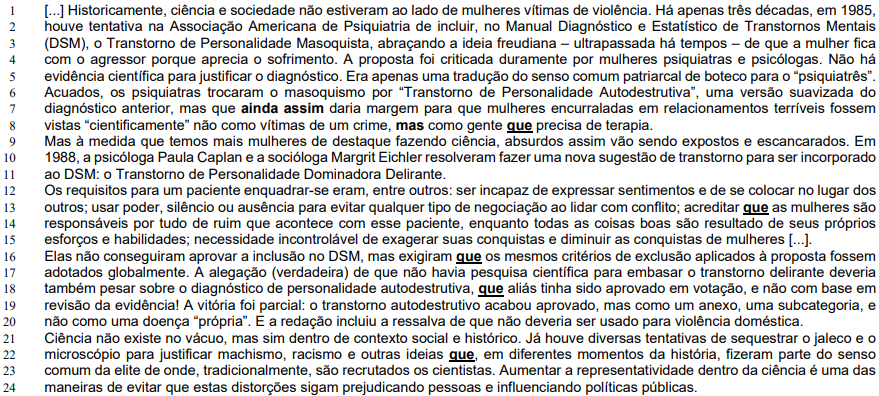Questões de Concurso
Comentadas para professor - letras
Foram encontradas 684 questões
Resolva questões gratuitamente!
Junte-se a mais de 4 milhões de concurseiros!
O texto a seguir é referência para a questão.
Violência e culpa Natalia
Pasternak

Disponível em: https://oglobo.globo.com/blogs/a-hora-da-ciencia/post/2023/03/violencia-e-culpa.ghtml. Adaptado.
O texto a seguir é referência para a questão.
Violência e culpa Natalia
Pasternak

Disponível em: https://oglobo.globo.com/blogs/a-hora-da-ciencia/post/2023/03/violencia-e-culpa.ghtml. Adaptado.
I- Educação indígena e quilombola; II- Anos iniciais do ensino fundamental urbano; III- Ensino médio parcialmente integrado à educação profissional; IV- Anos finais do ensino fundamental no campo.
Dos itens acima:
The study had as an aim to know the students’ performance in:
The history of technology in language teaching could not be linear in a country like ours where social differences prevent technologies such as paper, the book, and even the electricity is within everyone's reach. Many obsolete technologies, such as the slide projector, for example, have never reached in certain schools. The computer has already been integrated into the language teaching of some institutions and many teachers have already adopted a didactic material accompanied by CD-Roms. It has already been possible to observe a gradual change of many who rejected in principle the innovations brought by the computer and the Internet. Although this technology continues to be seen by some as a miracle cure and by others as something to be feared. It is quite possible that the computer does not reach everyone, but it is necessary to remind that neither the book nor the computer will be miracles in the learning process. The success of acquiring a foreign language depends on the learner’s insertion in activities of social practice of language (…).
(PAIVA, V. L. M, O USO DA TECNOLOGIA NO ENSINO DE LÍNGUAS ESTRANGEIRAS: breve retrospectiva histórica 2017, pag. 14 - Disponível em: http:// www.veramenezes.com/techist.pdf)
Extract 2
(…) I no longer need to make the case for computers to be provided in education, because computers are there in abundance in all their modern forms. We may see traditional computers in labs, teachers and students walking around with laptops or tablet PCs, and many people will have a mobile phone in their pocket that is capable of doing rather more than the mainframe computers that started computer-assisted language learning in the 1960s. I do recognise that there are many kinds of digital divide, and that this is not true everywhere.
What can put teachers off using technology
What is still sometimes an issue is the reliability of these technologies for classroom use. This can discourage teachers from making use of technology as often as they would want to. It's compounded by the fact that, if these teachers are working in schools, they are faced with classes of learners who may, on the surface at least, appear to be more digitally competent than their teachers are. Learners can therefore challenge their teachers, in ways that put the latter off using the technologies that could potentially make such a difference to what happens in the classroom. (…)
(Motteram, G., The benefits of new technology in language learning. Disponível em:https://www.britishcouncil.org/voices-magazine/the-benefits-newtechnology-language-learning. 18 September 2013.)
According to the extracts we can say:
Thus, analyze the sentences below and choose the true sentence (s) that point (s) this debate.
I - Many researches have emerged concerned about what the students have read, how they have read, and trying to evaluate if they have read better or worse influenced by new technologies of information and communication. II - The result of some researches has pointed that students have some insufficiency on texts comprehension. III - Some reflexions suggest that the students could have obtained worse results if the teachers had not worked well on reading in Brazilian elementary and high schools for decades. IV - Researches highlight the distance between what is idealized (by the theories) and what is realized (by the practices) in Brazilian education. V - The evaluative parameters used by an international organization that did not consider the cultural and social diversity and the complexity of these diversities the program aims to achieve.
Choose the correct affirmative.
The concept of "reading", therefore, becomes primarily the exercise of a path option by the page and the subsequent selective acquisition of partial information present in several places on the same page. This way, there is no need to read everything on the page, or read the page in one direction (top to bottom or left to right). Often, on a multimodal page (I mean, containing several means of communication: visual, written, sonic), the reader can choose between just listening to a sound text or watching a video clip inserted on the page, making the complex and multifaceted experience of reading" . (OCNs, 2006 : pág. 107)